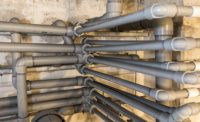Few backflow devices have as large a cloud of confusion hanging over them from engineers, inspectors and installers as chemical dispensers.
The operation of the device literally is shrouded, the installation is often done without inspection and there is a tube inserted into a cleaning solution at all times while connected to potable water. All of this can be very troubling at first glance. Let’s pick apart how these devices operate so they can be specified and installed with confidence to provide the proper protection.
What do we mean by chemical dispensers?
A chemical dispenser is a device that conforms to the ASSE 1055 standard. The device’s goal is to dilute a concentrated solution inline with a potable water connection, creating a ready-to-use mixed solution that can be dispensed with minimal waste and footprint. Imagine a concentrated fertilizer or herbicide attachment that connects to the end of your garden hose – the principle is similar.
Chemical dispensers are comprised of two main components in order from the inlet: a backflow prevention device and a mixing chamber. This two-part design can be applied to soap mixers at a car wash, bottle fillers in a janitor’s closet and laundry systems, to name a few. Most, if not all, of these cleaning products consist of high-hazard surfactants that cannot be in our potable water supply.
ASSE 1055 gives the performance requirements the device must meet in order to protect against such cleaners getting back into the water supply. It tests for back siphonage up to 12.3 psi while fouled, back pressure up to 10 ft. of water column (4.3 psi), a hydrostatic burst test to 150 psi and a life test to 5,000 cycles at 125 psi and 120° F (180° if meant for hot water).
To be clear: ASSE 1055 chemical dispensers give proper high-hazard backflow protection.
How to properly install chemical dispensers
As always, refer to the manufacturer’s installation instructions for the particular requirements for connecting their system to potable water.
There are four primary types of installations the reader should be aware of:
-
Dedicated connections;
-
Connections to hose bibs;
-
Connections to faucets.
Dedicated connections: These are rather straightforward in as the device is connected to a branch of the potable water supply that has no other use than for the chemical dispenser. The integral backflow protection in the ASSE 1055 device will protect the upstream water supply.
Connections to hose bibbs: Hose bibbs are required to have a hose connection vacuum breaker complying with ASSE 1011 installed on them. An ASSE 1011 device offers high-hazard protection. However, it cannot be under continuous pressure for more than 12 hours. Chemical dispensers normally employ a shutoff valve near their inlet. If the hose bibb is continuously open and the shutoff is closed, the ASSE 1011 device will not operate as designed. In theory, this is not an issue as the ASSE 1055 device will offer the backflow protection. However, if the chemical dispenser is ever removed, the hose bibb may not function correctly when other connections are made.
The recommendation is to not specify or install a chemical dispenser on a hose bibb that has an ASSE 1011 device installed. Furthermore, removing the ASSE 1011 device will damage the threads and a new hose bibb may need to be specified or installed. You may be familiar with this issue if you have tried to replace a leaky vacuum breaker in the past.
Connections to faucets: Faucets used in janitorial closets as a part of service sinks or utility sinks will normally have a 3/4-in. NHS thread on the end of the discharge so that a hose can be connected to it for filling mop buckets. The faucet is required to have backflow protection (such as an ASSE 1011 device); however, in many cases the protection has been removed for similar reasons to why someone would want to remove it from a hose bibb (e.g., leaks over time). This has led manufacturers to incorporate an atmospheric vacuum breaker (ASSE 1001) into the faucet itself. Knowing whether or not the faucet has a vacuum breaker is the first step.
If it is confirmed the faucet has no vacuum breaker, a direct connection may be made from the chemical dispenser to the spout. Be advised if the faucet is two-handled you may be putting the system at risk of a cross-connection if both hot and cold supplies are opened. Only open one of the supplies as directed by the chemical dispenser manufacturer.
If the faucet has a vacuum breaker or you cannot tell if a vacuum breaker device is present, a pressure-bleed device must be specified or installed. Its function is to prevent the long-term existence of pressure downstream of the vacuum breaker. Both the ASSE 1001 and ASSE 1011 devices allow for a maximum of 12 hours of exposure to pressure.
Furthermore, chemical dispensers typically have a shutoff valve at their inlet, which both ASSE 1001 and ASSE 1011 devices do not allow downstream of the devices. The relief valve basically is a tee connection with one end going to the ASSE 1055 device and the other to an orifice open to atmosphere. Yes, when you leave the faucet on, water will continually stream out into the sink. This is the signal to turn the water off.
What must not be installed is a diverter valve that closes the path to the sink and opens it to the chemical dispenser. This creates an open, pressurized pathway past the vacuum breaker. This only can be utilized if the faucet has no vacuum breaker and even then it is not recommended because you can’t observe if the faucet is on and a cross-connection is taking place.
It is my hope this helps shed some light on how ASSE 1055 chemical dispensers operate and need to be installed. They do provide the proper high-hazard backflow protection when specified or installed correctly.




